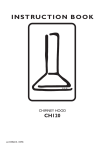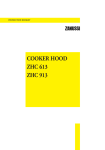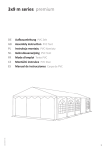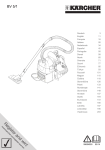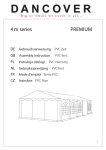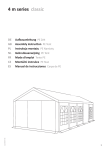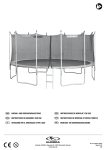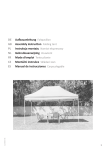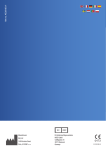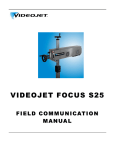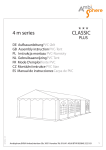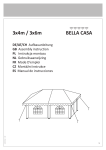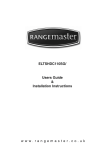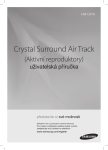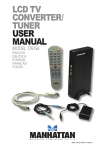Download 7 m series professional
Transcript
7 m series professional 02/2015-01 DE GB PL NL FR CZ ES IT Aufbauanleitung PVC Zelt Assembly instruction PVC Tent Instrukcja montażu PVC Namioty Gebruiksaanwijzing PVC Tent Mode d’emploi Tente PVC Montážni instrukce PVC Stan Manual de instrucciones Carpa de PVC Istruzioni di montaggio Tenda in PVC 1 7 m series professional DE/AT/CH Sicherheitshinweise Einführung Herzlichen Glückwunsch zum Kauf Ihres neuen Zeltes. Bei Fragen oder Tipps wenden Sie sich gerne an unser Kundenservice-Team oder an einen unserer autorisierten Handelspartner. Ihr Zelt können Sie nun flexibel einsetzen: zum Feiern, einfach als Sonnenschutz, als Unterstand, zur Lagerung u. v. m. Beachten Sie bitte die nachfolgenden Hinweise, damit Sie lange Freude an dem Zelt haben. Wichtig Lesen Sie diese Aufbauanleitung vor dem Gebrauch des Zeltes aufmerksam durch und bewahren Sie sie für eine spätere Verwendung auf. Das Zelt ist nicht auf Wind- und Schneelasten getestet worden. Somit können hierfür keine Garantien übernommen werden. Beachten Sie in solchen Fällen den Wetterbericht, um im Bedarfsfall das Zelt rechtzeitig zu sichern und/oder abzubauen. Warnhinweise Zelte sind als temporäre Unterkunft gedacht und sollten bei widrigen Witterungsverhältnissen abgebaut werden. Bitte bewahren Sie immer ausreichend Abstand zu Schläuchen, Gas- oder Elektroleitungen. Um Schäden diesbezüglich zu verhindern, informieren Sie sich bitte bei Ihren örtlichen Behörden. Beim Einsatz geeigneter Heizgeräte (Auskunft hierzu im Fachhandel) ist ein Abstand von mindestens 1,2 m zu jeg lichem Planenmaterial einzuhalten. Sie sollten auf keinen Fall offenes Feuer im Zelt machen und Heizgeräte mit offenen Flammen verwenden. Der Aufbauer ist verantwortlich für die angemessene Verankerung und damit für die Sicherheit des Zeltes. Die Verankerung muss regelmäßig geprüft werden, um stets die Sicherheit des Zeltes zu gewährleisten, Schäden am Zelt vorzubeugen und Dritte zu schützen. Eine richtige Verankerung erhöht die Lebensdauer der Einzelteile und des Zeltes als Ganzes. Tragen Sie beim Aufbau immer einen Helm, Handschuhe und stabile Schuhe. Das schwere Metall kann scharfe Kanten haben und durch die rosthemmende Behandlung ölig sein. Bei Schneefall muss unbedingt darauf geachtet werden, dass der Schnee regelmäßig und zeitnah von der Plane entfernt wird. Gleiches gilt nach starken Regenfällen oder Belastung durch andere Materialen. Bewahren Sie Ersatzteile für Kinder unzugänglich auf. Achtung Achten Sie darauf, dass der Untergrund für Ihre Nutzungszwecke geeignet ist. Suchen Sie einen ebenen Untergrund für das Zelt. Verwenden Sie nur die mitgelieferten Materialien. Berühren und/oder bearbeiten Sie die Planen nicht mit spitzen Gegenständen. Gummischlaufen sind Verschleißteile. Bei Materialermüdung sollten diese ersetzt werden. Das Zelt ist auch bei leichteren Minustemperaturen für einen Einsatz geeignet. Die Planen müssen aber bei mindestens 10 °C lange genug gelagert sein und bei diesen Temperaturen oder wärmer, entfaltet werden. Ansonsten kann es zu Bruchstellen an den gefalteten Stellen kommen. Jedes Land hat Vorschriften für das Errichten von mobilen- (Zelten) und immobilen Bauten. Ob eventuelle Genehmigungen für Ihren Nutzungszweck erforderlich sind, erfragen Sie bitte bei Ihrer örtlichen Behörde. In manchen Ländern ist die Zeltgröße entscheidend für eine eventuelle Genehmigung. 2 7 m series professional Vor dem ersten Gebrauch Packen Sie die Kartons aus und überzeugen sich anhand der Packliste, ob alle Teile vorhanden sind. Metallteile sind vom Hersteller durch einen leichten Ölfilm geschützt. Es kann passieren, dass manche Teile zu ölig. In diesem Fall nehmen Sie bitte einen Lappen und wischen das Öl ab. Dafür bitten wir um Entschuldigung. Planen Sie beim ersten Aufbau etwas mehr Zeit ein. Anschließend wird es immer zügiger gehen. Das Aufbauprinzip ist einfach. Beachten Sie unsere Bebilderung der Schritte. Die Verschraubung der Rohre mit den Verbindern führen Sie bitte manuell mit einem Inbusschlüssel aus oder mit einem Akkuschrauber auf maximal Stufe 2. Bitte schonen Sie das Material. Reinigung und Aufbewahrung Benutzen Sie zur Reinigung der Planen keine aggressiven Reinigungsmittel. Nehmen Sie einfach leichtes Laugen wasser. Das Zelt sollte nicht in nassem Zustand zusammengelegt und verpackt werden. Bewahren Sie das Zelt trocken auf. Sehen Sie davon ab, das Metallgestänge zu verändern: weder durch das Anbauen und/oder Anschweißen anderweitiger Materialien, noch durch Einkerbungen und/oder Verformungen des Materials. Gehen Sie vorsichtig mit den Einzelteilen um. Nutzen Sie beim Abbau wieder die Packliste und überprüfen Sie die Vollständigkeit, damit beim nächsten Aufbau alles wieder vorhanden ist. Achten Sie beim Lagern des Zeltes ebenfalls darauf, dass keine weiteren Gegenstände auf diesem liegen. Umwelt Tragen Sie zum Umweltschutz bei: Werfen Sie Ihr Zelt und/oder Teile davon nicht in den Hausmüll. Bringen Sie es zum Recycling zu einer offiziellen Sammelstelle oder wenden Sie sich an den Hersteller bzw. einen autorisierten Händler. Garantie und Kundendienst Wenn Sie weitere Informationen benötigen oder Probleme auftreten: schreiben Sie bitte eine E-Mail an helpme@TOOLPORT.de, oder setzen sich mit einem TOOLPORT Service-Center in Ihrem Land in Verbindung. Deutschland: 040 / 608 72 717; International: 00800 / 240 240 24. 3 7 m series professional GB Assembly Instructions Introduction Congratulations on the purchase of your new product and welcome to TOOLPORT. Our customer service department or authorised sales representative will be happy to answer your questions and give any valuable instructions. Your new tent will give you freedom to plan many activities. It can be used at a party, to screen you from the sunlight, as a shelter, for storage and in many other ways. Please observe the instructions provided below in order to extend the useful life of your tent. Important Please read these assembly instructions before usage of the tent and keep it for future reference. Safety The tent was not tested for wind and snow loads, unless that is clearly indicated by the manufacturer. Therefore, these loads are not covered by guarantee. Please watch the weather forecasts to be able to properly protect or disassemble the tent before problems appear. Warnings 1. 2. Tents are intended for temporary accommodation and should be taken down in adverse weather conditions. 3. hen using suitable heaters (available e. g. in specialist shops), keep a minimum distance of 1.2 m to tarp W material. Open fire or heaters with open flames such as patio heaters, umbrella heaters, gas heaters etc. should not be used in any case. 4. 5. 6. T he person setting up the tent is responsible for adequately securing it to ensure its safety. Please check the anchoring constantly to avoid damages. A stabil anchoring can extend the endurance of the tent. lways be sure to keep sufficient distance to hoses as well as gas and power lines to avoid possible damage. A Please check the area for power cables and gas lines. Ask your local autority for further information to avoid damages. lease wear head protection, gloves and solid shoes. The heavy metal parts could have sharp edges P and could be oily because of rust prevention treatment. lease make sure that there is no permanent snow load. It should be removed right away. The same applies P for rain and other forms of load. Children should not play with the spare parts of the tent. These components must be adequately protected. Please find a flat and even ground base to pitch the tent. Only those materials provided with the tent can be used. 4 7 m series professional Caution! Please check whether the ground base is suitable for your purpose. The tent can be used also during temperatures a few degrees below zero. However, prior to such use, the tarp material must be stored in temperature of at least 10 °C for a sufficiently long time, and then unwrapped at such, or higher temperature. Otherwise, the material may break at points of folds. Each country has separate regulations regarding movable structures (tents) and unmovable structures. Please ask your local authorities whether a permission be obtained to pitch the tent. In some countries this depends on the size of the tent. The tarps should not come into contact with any objects with sharp edges. Before first usage Please unpack the cartons and check against the packing list enclosed whether all parts have been delivered. Metal parts have been covered by a thin film of lubricant in the manufacturer‘s plant. Some parts may have more than the ordinary amount of lubricant on them. In such case, use a cloth to remove excess lubricant. Please excuse us for that. The screws joining the pipes with connectors must be tightened manually, using a hexagon key or an automatic screw driver, set at a max. level 2, to avoid material wear. Cleaning and storage Please do not use agressive chemicals to clean the tarp material. The best cleaning agent is water with slightly alkaline reaction. The tent should not be folded and packed when wet. First dry it thoroughly. Do not make any modifications of the metal structure of the tent, such as for example, connecting and/or welding additional loads, making grooves and/or any deformations. Please be careful when handling individual components of the tent. During disassembly, please use the lopacking list again to check the possible missing parts, so as to avoid problems with next assembly. Enviroment After the end of usage, please do not dispose of the tent or any of its components with ordinary garbage, but recycle it. If in doubt, please ask the manufacturer or an authorised sales representative. We will be happy to help you recycle the tent correctly, at the same time preserving the environment. Guarantee and customer services If you need any information or have any problems, please contact us at the following email address: helpme@TOOLPORT.de, or contact TOOLPORT Service-Center in your country. Our phone number is: 040 - 608 72 717 in Germany, or 00800 240 240 24 in foreign countries. 5 7 m series professional PL Instrukcja Wprowadzenie Gratulujemy zakupu naszego produktu i witamy w firmie TOOLPORT. Nasz dzial obslugi klienta lub autoryzowany przedstawiciel handlowy chetnie udzieli Państwu odpowiedzi na pytania i cennych wskazówek. Dzieki nowemu namiotowi maja Państwo mozliwosc swobodnego planowania wielu dzialań. Mozna go wykorzystac podczas imprezy, jako ochrone przed slońcem, wiate, do skladowania i w wielu innych celach. Prosimy o przestrzeganie zamieszczonych ponizej wskazówek. Pozwoli to Państwu dluzej korzystac z naszego namiotu. Wazne Przed uzyciem namiotu prosze uwaznie przeczytac instrukcje montazu i przechowac ja w celu pózniejszego wykorzystania. Bezpieczeństwo Namiot nie byl testowany pod katem obciazeń spowodowanych wiatrem i sniegiem, o ile brak jest wyraznej wskazówki producenta. Dlatego obciazenia te nie sa objete gwarancja. Prosimy o obserwowanie prognoz pogody, aby w razie potrzeby odpowiednio wczesniej zabezpieczyc namiot lub zdemontowac go. Ostrzezenia Namioty sa przeznaczone do uzytku tymczasowego i w przypadku niesprzyjajacych warunków atmosferycznych nalezy je zdemontowac. Namiot rozstawiac w odpowiedniej odleglosci od przewodów wodnych, gazowych i elektrycznych, aby ich nie uszkodzic. Prosze dowiedziec sie od lokalnych dostawców, gdzie przebiegaja wszelkie przewody, aby nie uszkodzic ich przy montazu namiotu. W przypadku uzywania odpowiednich grzejników (poprosić o rade sprzedawce) nalezy je ustawiac w odleglosci nie mniejszej niz 1,2 metra od plandeki. Pod zadnym pozorem nie wolno uzywac otwartego ognia ani grzejników z otwartym plomieniem, np. parasoli grzewczych, promienników ogrodowych, nagrzewnic gazowych itp. Osoba rozstawiajaca namiot jest odpowiedzialna za jego wlasciwe przytwierdzenie do podloza, a tym samym za bezpieczeństwo. Nalezy regularnie kontrolowac przytwierdzenie namiotu do podloza, aby zapewnic bezpieczeństwo namiotu, uniknac jego uszkodzenia i chronic innych uzytkowników. Prawidlowe przytwierdzenie namiotu do podloza wydluza trwalosc jego elementów skladowych oraz konstrukcji namiotu jako calosci. Podczas montazu namiotu nalezy nosic kask, rekawice oraz stabilne buty. Ciezkie elementy metalowe moga miec ostre krawedzie, a zabezpieczenie antykorozyjne powoduje, ze moga byc one sliskie. Podczas opadów sniegu nalezy regularnie i szybko usuwac zalegajacy snieg z plandeki. To samo dotyczy mocnych opadów deszczu oraz obciazenia plandeki innymi materialami. Dzieci nie powinny bawic sie czesciami zapasowymi namiotu. Elementy te nalezy odpowiednio zabezpieczyc. 6 7 m series professional Uwaga! Do rozstawienia namiotu prosze znalezc plaski i równy fragment terenu. Prosze uzywac tylko materialów dostarczonych wraz z namiotem. Prosze zwrócic uwage, czy podloze nadaje sie do przewidzianego przez Państwa celu. Namiot nadaje sie do uzytku takze podczas lekkiego mrozu. Plandeki musza byc jednak przedtem wystarczajaco dlugo skladowane w temperaturze przynajmniej 10 °C i rozwijane przy tej wlasnie lub wyzszej temperaturze. W przeciwnym razie miejsca zgiec moga popekać. Gumowe petelki naleza do czesci zuzywalnych. W razie zuzycia materialu nalezy je wymienic. W kazdym kraju obowiazuja odrebne przepisy dotyczace budowli ruchomych (namiotów) i nieruchomych. W lokalnych organach wladz nalezy dowiedziec sie, czy rozstawienie namiotu wymaga uzyskania pozwolenia. W niektórych krajach decyduje o tym wielkosć namiotu. Plandeki nie powinny miec kontaktu z zadnymi przedmiotami o ostrych krawedziach. Przed pierwszym uzyciem Prosze rozpakowac kartony i sprawdzic na podstawie zalaczonej listy zaladunkowej, czy wszystkie czesci zostaly dostarczone. Czesci metalowe zostaly pokryte przez producenta cienka warstwa smaru. Moze sie zdarzyc, ze na niektórych czesciach smaru jest zbyt wiele. Wówczas nalezy sciereczka usunać nadmiar smaru. Przepraszamy za to utrudnienie. Na pierwszy montaz nalezy zarezerwowac sobie troche wiecej czasu. Zasady rozstawiania namiotu sa proste. Prosze wspomagac sie rysunkowa instrukcja poszczególnych kroków montazu. Polaczenia srubowe rur z lacznikami nalezy wykonac recznie za pomoca klucza imbusowego lub automatycznej wkretarki ustawionej maks. na poziom 2, aby uniknac zuzycia materialu. Czyszczenie i przechowywanie Do czyszczenia planek prosze nie uzywac agresywnych srodków czyszczacych. Najlepsza do tego celu jest woda o lekkim odczynie alkalicznym. Namiotu nie wolno skladac i pakowac, gdy jest wilgotny. Najpierw nalezy go dokladnie wysuszyc. Nie wolno dokonywac zadnych zmian konstrukcji metalowej namiotu, np. przylaczac i/lub przyspawywac dodatkowych obciazeń, zlobic rowków i/lub dokonywać innych znieksztalceń. Prosze ostroznie obchodzic sie z poszczególnymi elementami namiotu. Podczas demontazu prosze skorzystac ponownie z listy zaladunkowej i sprawdzic kompletnosc, aby uniknac problemów przy nastepnym montazu. Podczas magazynowania namiotu w suchym miejscu prosze nie klasc na nim zadnych innych przedmiotów. Ochrona srodowiska Po zakończeniu okresu uzytkowania prosze nie wyrzucac namiotu lub jego elementów do zwyklych smieci, lecz poddac go przepisowemu recyklingowi. W razie watpliwosci prosze zwrócic sie do producenta lub autoryzowanego przedstawiciela handlowego. Chetnie pomozemy Państwu prawidlowo zutylizowac namiot, przyczyniajac sie w ten sposób do ochrony srodowiska. Gwarancja I obsluga klienta Jesli potrzebuja Pañstwo dalszych informacji lub wystapia jakies problemy, prosze skorzystać z naszego adresu e-mail: helpme@TOOLPORT.de, lub skontaktować sie z TOOLPORT Service-Center w Pañstwa kraju. Niemcy: 040 - 608 72 717; zagranica: 00800 240 240 24. 7 7 m series professional NL Gebruiksaanwijzing Inleiding Gefeliciteerd met de aankoop van ons product en welkom bij TOOLPORT. Onze klantenservice of de geautoriseerde dealer geven graag antwoord op al uw vragen en waardevolle aanwijzingen. Dankzij uw nieuwe tent heeft u de mogelijkheid om vrijuit allerlei activiteiten te plannen. U kunt hem gebruiken voor feesten, als bescherming tegen de zon, als afdak, voor opslag en vele andere doeleinden. Wij verzoeken u zich te houden aan onderstaande aanwijzingen. Hierdoor kunt u onze tent langer gebruiken. Belangrijk Lees de montagehandleiding voor gebruik aandachtig door en bewaar hem goed, zodat u hem later nog eens kunt raadplegen. Veiligheid De tent is zonder uitdrukkelijke aanwijzing van de producent niet getest voor op wind- en sneeuwbelasting. Deze vormen van belasting zijn daarom niet gedekt door de garantie. Houd in dergelijke gevallen de weersverwachtingen in de gaten en zorg voor tijdige verankering of demontage van de tent. Waarschuwingen 1. 2. T enten zijn bedoeld als tijdelijke beschutting en moeten bij slechte weersomstandigheden gedemonteerd worden. 3. ij gebruik van een geschikt verwarmingsapparaat (verkrijgbaar in de vakhandel) moet een afstand B van minstens 1,2 m tot het tentzeil worden aangehouden. Open vuur en verwarmingsapparaten met open vlam zoals terrasverwarmingen, gaskachels e.d. mogen in geen geval worden gebruikt. 4. e persoon die de tent opzet is verantwoordelijk voor de juiste verankering en daarmee voor de veiligheid D van de tent. Controleer de verankering van de tent op de ondergrond regelmatig om de veiligheid van de tent te verzekeren, beschadiging van de tent te voorkomen en andere gebruikers te beschermen. Correcte bevesti ging van de tent op de ondergrond vergroot de duurzaamheid van zijn onderdelen en de constructie van de tent als geheel. Z org steeds voor een aangepaste afstand tot slangen en gas- en elektriciteitsleidingen zodat deze niet beschadigd raken. Verzoek de lokale toeleveranciers om informatie over de loop van de diverse leidingen, zodat u tijdens het opzetten van de tent beschadigingen ervan kunt voorkomen. Draag een helm, handschoenen en stevige schoenen bij de montage van de tent. Zware metalen elementen kunnen scherpe randen hebben en door de anti-corrosiebehandeling zijn ze soms glad. Bij sneeuwval moet u regelmatig en snel de sneeuw van het tentzeil schuiven. Dit geldt ook bij hevige regenval en belasting van het tentzeil met andere materialen. Kinderen mogen niet spelen met de reserveonderdelen van de tent. Zorg dat deze onderdelen goed zijn opgeborgen. 8 7 m series professional Attentie! Zet de tent op een vlak en egaal gedeelte van het terrein. Gebruik uitsluitend materialen die zijn meegeleverd met de tent. Let erop dat de ondergrond geschikt is voor het doel waarvoor u hem wilt gebruiken. U kunt de tent ook gebruiken bij lichte vorst. De tentzeilen moeten daarvoor echter voldoende lang bij een temperatuur van minimaal 10 °C zijn bewaarde en bij diezelfde of een hogere temperatuur worden uitgevouwen. Anders kunnen de zeilen barsten op de plaats van de vouwen. De rubberen lussen zijn onderdelen die kunnen verslijten. Vervang ze wanneer ze versleten zijn. In elk land gelden andere voorschriften voor verplaatsbare (tenten) en niet-verplaatsbare bouwsels. Vraag bij de lokale autoriteiten na of voor het opzetten van de tent een vergunning nodig is. In sommige landen hangt dit af van de afmetingen van de tent. Voor het eerste gebruik Pak de dozen uit en controleer op basis van de bijgevoegde paklijst of alle onderdelen zijn geleverd. De metalen onderdelen zijn door de producent bedekt met een dun laagje smeermiddel. Het kan gebeuren dat er zich iets teveel smeermiddel op een onderdeel bevindt. Verwijder in dat geval de overmaat smeermiddel met een doekje. Excuses voor dit ongemak. Reserveer iets meer tijd wanneer u de tent voor de eerste keer opzet. De regels voor het opzetten van de tent zijn eenvoudig. Gebruik de instructietekeningen van de opeenvolgende montagestappen. Maak de schroefverbindingen van de buizen met de koppelstukken met de hand, met behulp van een inbussleutel of met een automatische schroevendraaier die maximaal op niveau 2 is ingesteld. Hiermee voorkomt u slijtage van het metaal. Reiniging en opslag Gebruik geen agressieve schoonmaakmiddelen voor de reiniging van de tentzeilen. Gebruik hiervoor gewoon een milde loogoplossing. De tent niet opvouwen en inpakken wanneer hij vochtig is. Laat de tentzeilen eerst drogen en sla de tent droog op. Het is niet toegestaan om wijzigingen aan te brengen in de metalen constructie van de tent, bv. door er extra belasting aan te koppelen en/of lassen, inkepingen of andere vervormingen van het materiaal te maken. Behandel alle onderdelen van de tent voorzichtig. Maak bij het afbreken opnieuw gebruik van de paklijst en controleer of de tent compleet is. Hiermee voorkomt u problemen wanneer u de tent de volgende keer opzet. Leg tijdens de opslag op een droge plaats geen andere voorwerpen op de tent. Milieu Gooi de tent of onderdelen ervan na afloop van de gebruiksperiode niet bij het gewone huisvuil. Breng hem naar en officieel inzamelpunt voor recycling. Neem bij twijfel contact op met de producent of de geautoriseerde dealer. Wij helpen u graag bij de juiste verwijdering van de tent en dragen daarmee bij aan de bescherming van het milieu. Garantie Garantie en klantenservice Wenst u verdere informatie of treden er problemen op? Neem dan contact op per e-mail: helpme@TOOLPORT.de of met het TOOLPORT Service Center in uw land. Duitsland: 040 - 608 72 717; buitenland: 00800 240 240 24. 9 7 m series professional FR Mode d’emploi L´introduction Nous vous félicitons pour l‘achat de notre produit et soyez les bienvenus dans notre société TOOLPORT. Notre service client ou le représentant commercial agréé vous fourniront avec plaisir des réponses à vos questions et des indications précieuses. Grâce à la nouvelle tente, vous avez la possibilité de planifier librement plusieurs actions. Vous pouvez l‘utiliser pendant une fête en tant que protection contre le soleil, le vent, pour l‘entreposage et pour beaucoup d‘autres buts. Nous vous prions de respecter les indications énumérées ci-après. Cela vous permettra de profiter plus longtemps de notre tente. Important Avant de commencer à utiliser la tente, veuillez lire attentivement la notice de montage et la garder en vue d‘en profiter ultérieurement. La sécurité La tente n‘a pas été testée par rapport aux charges causées par le vent et la neige, si ce n‘est pas manifestement indiqué par le fabricant. En conséquence, la garantie ne couvre pas ce type de charges. Veuillez suivre les prévisions météo et en cas de besoin protéger la tente convenablement plus tôt ou la démonter. Les avertissements 1. 2. L es tentes sont destinées à des usages de loisirs temporaires et elles doivent être démontées en cas de conditions atmosphériques défavorables. 3. E n cas d‘utilisation des appareils de chauffage adaptés (se renseigner auprès d‘un vendeur spécialisé), respectez une distance minimale de 1,2 m par rapport à chaque matériau de bâche. Les feux ouverts de même que les appareils de chauffage à flammes nues tels que les champignons chauffants, les radiateurs de terrasses, les chauffages au gaz etc. ne peuvent en aucun cas être utilisés. 4. L ‘installateur de la tente est responsable de son ancrage adéquat au sol et donc de la sécurité de la tente. Il convient de régulièrement contrôler l‘ancrage de la tente au sol pour assurer la sécurité de la tente, éviter son endommagement et protéger d‘autres utilisateurs. L‘ancrage convenable de la tente permet de prolonger la vie de ses éléments composants et de la construction de la tente en tant qu‘ensemble. euillez respecter une distance appropriée par rapport aux tuyaux, aux conduites de gaz ou aux lignes électriques V afin d‘éviter de les endommager. Veuillez vous renseigner auprès des fournisseurs locaux où se trouvent tous les conduits afin d‘éviter de les endommager lors du montage de la tente. Au cours de la phase de montage, il convient de porter le casque, les gants et les chaussures assurant la stabilité. Les éléments métalliques lourds peuvent avoir des arêtes vives et la protection anti-corrosion peut les rendre glissantes. En cas de chutes de neige il convient d‘enlever régulièrement et rapidement la neige couvrant la bâche. Cela concerne aussi d‘intenses chutes de pluie et d‘autres matériaux chargeant la bâche. Les enfants ne peuvent pas jouer avec les éléments de rechange pour la tente. Il faut convenablement protéger ces éléments. 10 7 m series professional Attention! Pour installer la tente veuillez trouver un fragment de terrain plat et régulier. Veuillez utiliser seulement les éléments fournis avec la tente. Veuillez vérifier si le sol peut vous servir à réaliser le but prévu. Il est possible d‘utiliser la tente lorsqu‘il gèle légèrement. Pourtant, il faut tout d‘abord stocker les bâches suffi samment longtemps à température minimale de 10 °C et les déplier à la même température ou à la temperature plus élevée. Dans le cas contraire, les plis peuvent se rompre. Les attaches en caoutchouc sont les éléments qui s‘usent. En cas d‘usure du matériau, il convient de le remplacer. Dans chaque pays, les dispositions distinctes concernant les installations mobiles (tentes) et immobiles sont en vigueur. Il convient de se renseigner auprès des autorités locales si l‘installation de la tente exige l‘obtention de l‘autorisation. Dans certains pays ce sont les dimensions de la tente qui décident. Il convient de protéger les bâches contre le contact avec les objets ayant des arêtes vives. Avant la première utilisation Veuillez ouvrir les cartons et vérifier si tous les éléments ont été fournis, en basant sur la liste jointe. Le fabricant a couvert les éléments métalliques d‘une couche fine de graisse. Il peut arriver que certains éléments ont une couche trop épaisse de graisse. Dans ce cas, il faut éliminer l‘excès de la graisse en utilisant un morceau de tissu. Veuillez nous excuser pour cet empêchement. Il convient de prévoir plus de temps pour le premier montage. Les principes concernant l‘installation de la tente sont simples. Veuillez suivre les images du schéma de monatge, relatives aux étapes particulières. Il convient de faire manuellement les assemblages par boulons des tuyaux et des joints à l‘aide d‘une clé allen ou d‘un tournevis électrique mis au maximum en position « niveau 2 » pour éviter l‘usure du matériau. Le nettoyage et le stockage N‘utilisez pas les produits d‘entretien agressifs pour nettoyer les bâches. L‘eau légèrement alcaline est le meilleur moyen à ces fins. Il est interdit de plier et d‘emballer la tente lorsqu‘elle est humide. Tout d‘abord, il faut bien la sécher. Il est interdit de modifier la construction métallique de la tente d‘une manière quelconque par exemple d‘attacher et/ou de fixer par soudage les charges supplémentaires, de faire des rainures et/ou de faire d‘autres déformations. Soyez prudents avec les éléments particuliers de la tente. Lors du démontage veuillez suivre la liste de chargement et vérifier si tous les éléments sont réunis pour éviter les problèmes lors du montage suivant. Ne posez aucun autre objet sur la tente au cours du stockage dans un endroit sec. La protection de l‘environnement Après avoir terminé de l‘utiliser, ne jettez pas la tente ou ses éléments à la poubelle avec les déchets ménagers mais il convient de les faire recycler conformément aux dispositions étant en vigueur. En cas de doutes, veuillez contacter le fabricant ou le représentant commercial agréé. Nous vous aiderons avec plaisir à recycler la tente d‘une manière convenable en contribuant de cette manière à la protection de l‘environnement. La garantie et le service client Pour plus d‘informations ou en cas de problèmes, merci de nous écrire à l‘adresse mail : helpme@TOOLPORT.de ou de contacter TOOLPORT Service-Center dans votre pays. Allemagne : 040 - 608 72 717; étranger : 00800 240 240 24. 11 7 m series professional CZ Bezpečnostní upozornění Úvod Blahopřejeme vám k nákupu vašeho nového stanu. V případě dotazů se můžete kdykoliv obrátit na tým našeho zákaznického servisu nebo na některého z našich autorizovaných prodejních partnerů. Stan nyní můžete flexibilně využívat: na oslavy, prostě jako ochranu před slunečním svitem, jako přístřešek, na skladování atd. Mějte prosím na paměti následující upozornění, abyste ze stanu dlouho měli užitek a potěšení. Důležité Před použitím stanu si pozorně přečtěte návod k sestavení a návod uschovejte pro pozdější použití. Bezpečnost Stan nebyl testován na větrnou a sněhovou zátěž. V těchto ohledech nemůžeme poskytnout žádné záruky. Dbejte v takových případech předpovědi počasí, abyste stan mohli podle potřeby včas zabezpečit a/nebo rozebrat. Výstražná upozornění Stany mají sloužit pro dočasné ubytování a měly by se při nepříznivém počasí rozebrat. Vždy prosím dodržujte dostatečnou vzdálenost od hadic a vedení plynu či elektřiny. Abyste po této stránce předešli škodám, informujte se prosím u místních úřadů. Při použití vhodných topných těles (potřebné informace získáte ve specializovaném obchodě) je třeba dodržet vzdálenost minimálně 1,2 m od jakéhokoliv plachtového materiálu. V žádném případě byste ve stanu neměli rozdělávat otevřený oheň a používat ohřívače s otevřeným plamenem. Osoba, která stan staví, zodpovídá za přiměřené ukotvení, a tím za bezpečnost stanu. Ukotvení se musí pravidelně kontrolovat, aby vždy byla zajištěna bezpečnost stanu, aby se předešlo poškození stanu a aby nebyly ohroženy osoby v okolí. Správným ukotvením se zvyšuje životnost jednotlivých dílů i stanu jako celku. Při sestavování stanu vždy noste helmu, rukavice a stabilní obuv. Těžký kov může mít ostré hrany a v důsledku antikorozního ošetření může být naolejovaný. Při sněžení je nezbytné dbát na to, aby sníh byl z plachty pravidelně a včas odstraňován. Totéž platí při silných dešťových srážkách či zatížení jinými materiály. Náhradní díly skladujte tak, aby nebyly dostupné dětem. 12 7 m series professional Pozor! Dbejte na to, aby podklad byl vhodný pro vaše účely použití. Vyberte pro stan rovný podklad. Používejte pouze dodané materiály. Nedotýkejte se plachet a neupravujte je ostrými předměty. Gumové smyčky jsou součásti podléhající rychlému opotřebení. Při únavě materiálu je třeba je vyměnit. Stan je vhodný pro používání také při mírně záporných teplotách. Plachty se však musejí dostatečně dlouho skladovat při minimálně 10 °C a při této nebo vyšší teplotě se musejí rozprostřít. Jinak mohou na přehybech vzniknout zlomy. Každá země má vlastní předpisy pro budování mobilních stanů a nemobilních staveb. Zda pro váš účel použití jsou případně zapotřebí nějaká povolení, zjistíte na místním úřadě. V mnoha zemích je pro případné povolení rozhodující velikost stanu. Před prvním použitím Vybalte krabice a podle seznamu obsahu balení se přesvědčte, zda nechybí žádné díly. Kovové díly jsou výrobcem chráněny tenkým olejovým filmem. Může se stát, že některé díly budou naolejované příliš. V takovém případě prosím vezměte hadřík a olej setřete. Prosíme za prominutí. Na první sestavování stanu si nechte o něco více času. Při každém dalším sestavování bude postup rychlejší. Princip sestavení je jednoduchý. Dbejte našich vyobrazení jednotlivých kroků. Trubky se spojovacími prvky prosím sešroubujte pomocí inbusového klíče nebo pomocí bateriového šroubováku max. na úrovni 2. Šetřete materiál. Čištění a skladování K čištění plachet nepoužívejte agresivní čisticí prostředky. Stačí použít lehký mýdlový roztok. Stan by se neměl skládat a balit v mokrém stavu. Uchovávejte stan suchý. Neprovádějte žádné úpravy kovových tyčí: ať už přistavěním a/nebo přivařením jiných materiálů, tvorbou zářezů a/nebo deformacemi materiálu. Zacházejte s jednotlivými díly obezřetně. Při rozebírání opět použijte seznam obsahu balení a zkontrolujte, zda žádné součásti nechybí, aby při příštím sestavování bylo opět vše k dispozici. Při skladování stanu rovněž dbejte na to, aby na něm neležely žádné další předměty. Životní prostředí Přispějte k ochraně životního prostředí: Nevyhazujte stan ani jeho části do komunálního odpadu. Doneste je k recyklaci na oficiální sběrné místo nebo se obraťte na výrobce, příp. autorizovaného prodejce. Záruka a zákaznický servis Budete-li potřebovat další informace nebo pokud se vyskytnou problémy, napište prosím e-mail na adresu helpme@TOOLPORT.de nebo se obraťte na servisní centrum společnosti TOOLPORT ve vaší zemi. 13 7 m series professional ES Manual de instrucciones Introducción Enhorabuena por comprar nuestro producto y bienvenido a la empresa TOOLPORT. Nuestro departamento de aten ción al cliente o un representante comercial autorizado responderán a sus preguntas y le aconsejarán. Gracias a la nueva carpa, podrá planear con libertad numerosas actividades. Puede utilizarla durante celebraciones, como protección contra el sol, como refugio, para almacenar cosas o con muchos otros fines. Le rogamos que siga las siguientes indicaciones para disfrutar durante más tiempo de nuestra carpa. Importante Antes de usar la carpa, lea atentamente las instrucciones de montaje y consérvelas para utilizarlas más tarde. Seguridad No se ha probado la resistencia de la carpa a cargas de viento y nieve, siempre que el fabricante no lo haya indicado expresamente. Por eso, la garantía no cubre estas cargas. Le rogamos que compruebe el pronóstico del tiempo para asegurar o desmontar la carpa en caso de necesidad. Advertencias 1. 2. L as carpas han sido diseñadas como alojamiento temporal y deben desmontarse en caso de condiciones atmosféricas desfavorables. 3. S i se utilizan calefactores adecuados (infórmese en un comercio especializado), se ha de mantener una distancia de al menos 1,2 m con el material de las lonas. No haga nunca fuegos al aire libre ni utilice calefactores con llamas libres, como estufas para terrazas, calentadores de gas, etc. 4. L a persona que instale la carpa es responsable de realizar un anclaje adecuado de la misma para garantizar su seguridad. Compruebe regularmente el anclaje de la carpa al suelo para garantizar la seguridad de la carpa, evitar que sufra daños y proteger a sus usuarios. El correcto anclaje de la carpa al suelo prolonga la vida útil de sus elementos y de la estructura de la carpa en su totalidad. rocure que siempre haya una distancia adecuada con tubos y conducciones de gas o electricidad para evitar P que se dañen. Pregunte a las autoridades locales sobre la localización de los cables para no dañarlos al montar la carpa. Lleve siempre casco, guantes y calzado estable durante el montaje de la carpa. Los elementos pesados de metal pueden tener bordes afilados y la protección anticorrosión puede hacer que estén resbaladizos. Cuando nieve, asegúrese de retirar la nieve de la lona con regularidad y rapidez. Haga lo mismo en caso de lluvias intensas o cuando la lona esté cargada con otros materiales. Los niños no deben jugar con las piezas de recambio de la carpa. Manténgalas fuera de su alcance. 14 7 m series professional ¡Atención! Busque un terreno plano y liso para montar la carpa. Utilice solo los materiales incluidos en la entrega. Compruebe que el suelo sea apropiado para el uso previsto. La carpa también se puede utilizar con unos pocos grados bajo cero. No obstante, las lonas deben haber estado almacenadas el tiempo suficiente a una temperatura mínima de 10°C y haber sido montadas a una temperatura igual o superior. En caso contrario, podría romperse en las zonas de los dobleces. Las gomas son piezas de desgaste. En caso de deterioro del material hay que cambiarlas. Cada país tiene su propia normativa sobre la instalación de carpas móviles y fijas. Pregunte a las autoridades locales si se requiere un permiso para montar la carpa. En algunos países lo importante es el tamaño de la carpa. Asegúrese de que las lonas no tengan contacto con ningún objeto afilado. Antes del primer uso Desembale los cartones y compruebe con la lista de envío que estén todas las piezas. El fabricante ha cubierto las piezas de metal con una capa fina de lubricante. Puede que en algunas piezas haya demasiado lubricante. En tal caso, retire el exceso con un paño. Disculpen las molestias. Para el primer montaje hay que reservar un poco de tiempo. Los principios de montaje son sencillos. Siga todos los pasos mostrados en los dibujos de las instrucciones. Atornille los tubos con los conectores manualmente con ayuda de una llave Allen o con un atornillador eléctrico a un nivel máximo de 2 para evitar que se desgaste el material. Limpieza y almacenamiento No utilice productos de limpieza agresivos para limpiar las lonas. Emplee solo agua ligeramente alcalina. No se debe doblar ni guardar la carpa cuando esté mojada. Primero hay que secarla minuciosamente. No se deben realizar cambios en la estructura metálica de la carpa, p.ej. añadir y/o soldar más cargas, hacer muescas y/o deformar el material. Tenga cuidado con los elementos de la carpa. Al desmontarla, utilice de nuevo la lista de envío y compruebe que estén todos los elementos para evitar problemas al volver a montarla. Guarde la carpa en un lugar seco; no coloque ningún objeto sobre ella. Protección del medio ambiente Al finalizar la vida útil, no tire la carpa ni sus piezas con la basura doméstica; llévelas a un punto limpio. En caso de duda, acuda al fabricante o a un representante comercial autorizado. Le ayudaremos a reciclar la carpa, protegiendo así el medio ambiente. Garantía y atención al cliente Si necesita más información o tiene algún problema, escríbanos a la dirección de e-mail: helpme@TOOLPORT.de o póngase en contacto con un centro de atención de TOOLPORT en su país. Alemania: 040 - 608 72 717; extranjero: 00800 240 240 24. 15 7 m series professional IT Manuale di istruzioni Introduzione Ci congratuliamo per l‘acquisto del nostro prodotto e Vi diamo il benvenuto nella ditta TOOLPORT. Il nostro reparto servizio clienti o un rappresentante autorizzato risponderanno a tutte le Vostre domande e forniranno indicazioni utili. Grazie alla nuova tenda avrete la possibilità di pianificare liberamente diverse operazioni. Il prodotto potrà essere utilizzato nel corso di eventi, come protezione dal sole, tettoia, magazzino e con molte altre finalità. Vi preghiamo di rispettare le indicazioni riportate a seguire. Ciò Vi permetterà di fruire più a lungo della nostra tenda. Importante Prima di utilizzare la tenda, leggere attentamente le istruzioni per il montaggio e conservarle per futura referenza. Sicurezza La tenda non è stata testata per quanto concerne la resistenza al carico eolico ed al peso della neve, sempre che il fabbricante non fornisca chiare indicazioni in proposito. Per questo motivo, i carichi summenzionati non sono compresi nella garanzia. Siete pregati di controllare le previsioni del tempo, in modo tale da poter mettere in sicurezza o da smontare la tenda. Avvertenze 1. 2. L e tende sono destinate ad un uso temporaneo. In caso di condizioni atmosferiche svantaggiose dovranno essere smontate. 3. ualora decidiate di utilizzare radiatori adeguati (chiedere consiglio al rivenditore), gli articoli dovranno essere Q posizionati ad una distanza di almeno 1,2 m dal telo. Non accendere fuochi e non usare radiatori con fiamme liberi (ombrelli termici, radiatori da giardino, generatori d‘aria calda a gas ecc.). 4. L ‘addetto al montaggio della tenda sarà responsabile del suo corretto fissaggio al piano d‘appoggio e del mantenimento di condizioni di sicurezza adeguate. Controllare regolarmente il fissaggio della tenda al piano d‘appoggio, in modo tale da garantire la sicurezza della costruzione, evitare il suo danneggiamento e proteggere gli altri utenti. Il corretto fissaggio prolungherà la durata dei componenti e dell‘intera struttura della tenda. ollocare la tenda ad una distanza adeguata da condotte dell‘acqua, del gas e da cavi elettrici, in modo tale da C non danneggiarli. Per evitare il loro danneggiamento nel crso del montaggio della tenda, chiedere informazioni relative alla posizione dei cavi e delle condotte ai fornitori locali. Durante il montaggio della tenda sarà necessario indossare un casco, guanti e calzature stabili. Gli elementi in metallo più pesanti possono avere bordi taglienti, mentre il trattamento anticorrosione li rende scivolosi. In caso di precipitazioni nevose, rimuovere regolarmente e tempestivamente la neve presente sul telo. Le stesse operazioni andranno svolte in caso di forti piogge o qualora il telo sia appesantito da altri materiali. I bambini non dovranno giocare con i pezzi di ricambio della tenda. Questi elementi dovranno essere messi adeguatamente in sicurezza. 16 7 m series professional Nota! Per il montaggio della tenda, trovare una porzione di terreno piana e priva di irregolarità. Usare soltanto i materiali forniti insieme alla tenda. Controllare che il piano di appoggio sia adatto all‘uso previsto. La tenda potrà essere usata anche in presenza di temperature leggermente inferiori allo zero. I teli, tuttavia, dovranno essere conservati ad una temperatura di almeno 10C sufficientemente a lungo. Anche lo srotolamento dei teli dovrà avvenire ad una temperatura uguale o superiore a quella sopraindicata. In caso contrario, sulle pieghe potranno comparire crepe. Gli elastici in gomma sono pezzi soggetti ad usura. Qualora si consumino dovranno essere sostituiti. In ogni paese vigono norme differenti relative alle costruzioni mobili (tende) ed immobili. Accertarsi presso le autorità locali relativamente all‘eventuale necessità di ottenere un permesso per il posizionamento della tenda. In alcuni paesi il fattore chiave è costituito dalle dimensioni della tenda stessa. Prima del primo utilizzo Aprire gli scatoloni e verificare che tutti gli elementi siano stati consegnati, controllando la lista allegata. I pezzi in metallo sono stati coperti dal fabbricante con un sottile strato di lubrificante. Su alcuni di essi la quantità di grasso può essere eccessiva. In questo caso si consiglia di eliminare l‘eccesso con un panno. Ci scusiamo per l‘inconveniente. Consigliamo di dedicare più tempo al primo montaggio. Le regole di posizionamento della tenda sono semplici. Fare riferimento all‘istruzione allegata con le varie fasi di montaggio. Realizzare i collegamenti degli elementi tubolari con le piastre di collegamento servendosi di una chiave a brugola o di un trapano svita-avvita automatico, impostato ad un livello non superiore a 2 (onde evitare l‘usura del materiale). Pulizia e conservazione Per la pulizia dei teloni, non utilizzare detergenti aggressivi. Il prodotto migliore è costituito da acqua leggermente alcalina. La tenda non potrà essere smontata e confezionata qualora sia umida. Prima di farlo, dovrà essere asciugata accuratamente. Non apportare modifiche alla struttura metallica della tenda (ad es. collegare e/o saldare carichi aggiuntivi), realizzare scanalature e/o altre deformazioni. Maneggiare accuratamente i vari elementi della tenda. Durante lo smontaggio, utilizzare nuovamente la lista di carico e verificare la sua completezza, in modo tale da evitare problemi nel corso del montaggio successivo. Durante lo stoccaggio della tenda in un luogo asciutto, non posare su di essa oggetti pesanti. Protezione ambientale Al termine del periodo di uso, non gettare la tenda o i suoi elementi insieme ai rifiuti domestici, ma sottoporli ad una procedura di riciclaggio. In caso di dubbi, rivolgersi al fabbricante o a un rappresentante commerciale autorizzato. Saremo lieti di aiutarVi a smaltire la tenda, contribuendo alla tutela ambientale Garanzia e servizio client Qualora abbiate bisogno di altre informazioni o vi siano problemi, Vi preghiamo di contattare il nostro indirizzo di posta elettronica: helpme@TOOLPORT.de o contattare il Centro Servizi TOOLPORT del Vostro paese. Germania: 040-608 72 717; estero 00800 240 240 24. 17 7 m series professional fire-resistan t Das PVC Material ist untersucht nach: The PVC fabric is tested following: D DIN 4102 – B1/B2 F M1/M2 PL EN 13501-1 NL B L EN 13501-1 DK S N SIS 650082 A CH EN 13501-1 BKZ 5.2 DE Besonderheiten Das Zelt ist schwer enlammbar, hochwerg und mit einer geprüen PVC-Haut gemäß DIN 4102- B1/B2 (A - EN 13501-1, CH - BKZ 5.2, DK, S N - SIS 650082, NL, B, L - EN 13501-1, PL - EN 13501-1, F - M1/M2) ausgestaet. Damit gilt das PVC-Material als schwer enlammbar und kann somit auch auf öffentlichen Events eingesetzt werden. GB Characteriscs The high-quality tent is flame-resistant. It is equipped with a cerfied PVC skin according to DIN 4102- B1/B2 (A - EN 13501-1, CH - BKZ 5.2, DK, S N - SIS 650082, NL, B, L - EN 13501-1, PL - EN 13501-1, F - M1/M2). Consequently the PVC fabric is considered flame-resistant and can therefore be used for public events. PL Właściwości Namiot jest wykonany z wysokiej klasy trudnopalnych materiałów. Pokrycie PCW spełnia wymogi DIN 4102- B1/B2 (A - EN 13501-1, CH - BKZ 5.2, DK, S N - SIS 650082, NL, B, L - EN 13501-1, PL - EN 13501-1, F - M1/M2). Materiał PCW jest materiałem trudnopalnym i może być stosowany również podczas imprez masowych. NL Bijzonderheden De tent is moeilijk ontvlambaar, hoogwaardig en voorzien van een geteste PVC-bekleding conform DIN 4102- B1/B2 (A - EN 13501-1, CH - BKZ 5.2, DK, S N - SIS 650082, NL, B, L - EN 13501-1, PL - EN 13501-1, F - M1/M2) . Daarmee geldt het PVC-materiaal als moeilijk ontvlambaar en kan het voor openbare events worden gebruikt. FR Parcularités La tente est ignifuge, de grande qualité et équipée d’une peau en PVC éprouvée suivant DIN 4102- B1/B2 (A - EN 135011, CH - BKZ 5.2, DK, S N - SIS 650082, NL, B, L - EN 13501-1, PL - EN 13501-1, F - M1/M2) . Par conséquent, le matériau PVC est considéré comme ignifuge et ulisable pour des manifestations publiques. CZ Zvláštnos Stan je nesnadno hořlavý, kvalitní a je vybavený pláštěm z PVC, ověřeným dle norem DIN 4102-B1/B2 (A – EN 13501-1, CH – BKZ 5.2, DK, S, N – SIS 650082, NL, B, L – EN 13501-1, PL – EN 13501-1, F – M1/M2). V souladu s těmito normami je materiál (PVC) nesnadno hořlavý, a může se proto používat i při veřejných akcích. ES Parcularidades La carpa es di¬cilmente inflamable, de alta calidad y está equipada con una capa de PVC comprobada según DIN 4102B1/B2 (A - EN 13501-1, CH - BKZ 5.2, DK, S N - SIS 650082, NL, B, L - EN 13501-1, PL - EN 13501-1, F - M1/M2) . El material de PVC se considera di¬cilmente inflamable y por tanto también puede ulizarse para eventos públicos. 18 7 m series professional Inhalt / Contents / Zawartość / Inhoud / Contenu / Obsah / Contenido Artikel Nr. Beschreibung ID Nr. 10m 12m 14m 31612 Stange 1700 mm 50-50 1 24 28 32 30902 Stange 1915 mm 38-38 2 31 38 45 30899 Stange 1915 mm 38-38 mit Loch 3 4 4 4 31613 Stange 1735 mm Dachstrebe horizontal 4 12 14 16 31614 Stange 665 mm Dachstrebe vertikal 5 6 7 8 30437 Stange 1174 mm 25-25 Diagonalstrebe 6 4 4 4 32220 Stange 1283 mm 50-50 7 12 14 16 32221 Stange 1283 mm 50-50 mit Löchern 8 12 14 16 31615 Stange 2230 mm 38-38 9 6 6 6 31642 3er Eckverbinder 110° 54-42 mit Ringen links 10 2 2 2 31643 3er Eckverbinder 110° 54-42 mit Ringen rechts 11 2 2 2 30527 3er Eckverbinder 140° 54-42 mit Ringen 12 2 2 2 30528 4er Eckverbinder 140° 54-42 mit Ringen 13 2 2 3 30529 4er Eckverbinder 110° 54-42 mit Ringen 14 4 4 6 30892 4er Eckverbinder 140° 54-42 15 2 3 3 30893 4er Eckverbinder 110° 54-42 16 4 6 6 30894 Kreuzstück 54-42 17 8 10 12 19 7 m series professional Inhalt / Contents / Zawartość / Inhoud / Contenu / Obsah / Contenido Artikel Nr. Beschreibung ID Nr. 10m 12m 14m 30895 T-Stück 54-42 18 4 4 4 31158 3-fach Verbinder Fuß links 19 2 2 2 31157 3-fach Verbinder Fuß rechts 20 2 2 2 30897 3-fach Verbinder Fuß Seitenwände 21 8 10 12 30898 3-fach Verbinder Fuß Endwände 22 4 4 4 31641 Spanner für die Seiten 23 8 12 12 30222 Erdnägel 40 cm 24 12 14 16 30048 Erdnägel 8x300 mm 25 12 14 16 30046 Erdnägel 4x180 mm 26 30 36 42 30914 Schraube 50 mm 27 82 96 110 30915 Schraube 70 mm 28 74 86 98 30384 Schraube 30 mm 29 24 28 32 30404 Schraube 45 mm 30 4 4 4 30405 Schraube 65 mm 31 4 4 4 30052 Flügelmutter 32 24 28 32 30407 Hutmutter 33 8 8 8 30430 Gummischlaufe 14 cm 34 204 230 256 20 7 m series professional Inhalt / Contents / Zawartość / Inhoud / Contenu / Obsah / Contenido Artikel Nr. Beschreibung ID Nr. 10m 30429 Gummischlaufe 5 cm 35 16 16 16 30085 Spannleine 5 m 36 4 4 4 30051 Dachhaken 37 12 14 16 30382 Inbusschlüssel 38 1 1 1 Dach 39 1 1 1 Seitenwand 40 10 12 14 Endwand 41 2 2 2 12m 14m 21 7 m series professional Aufbauanleitung Suchen Sie einen ebenen Untergrund für das Zelt. Packen Sie die Kartons aus und sehen Sie nach, ob auch alle hier aufgelisteten Teile vorhanden sind. Entfernen Sie vor dem Aufbau den leichten Ölfilm mit einem Tuch. Bei kälterem Wetter empfehlen wir, die Zeltplane vorher auf Zimmertemperatur zu bringen. Beim Montieren achten Sie bitte darauf das die Muttern immer innen liegen. 1 Setzen Sie den Rahmen für das Dach zusammen indem Sie die Teile (10 bis 18) an die Stangen (1, 2 und 3) montieren und zur Fixierung mit den Schrauben (27 und 28) anziehen. 11 10 10 ≠ 11 19 ≠ 20 30384 30404 30405 7x10m 30914 10 11 20 19 20 16 14 14 19 16 11 10 3 1 18 1 1 17 2 1 2 1 17 2 18 1 1 17 2 13 1 3 1 17 2 13 1 2 2 1 1 17 17 17 17 1 16 2 1 14 2 2 1 14 18 2 2 1 2 1 15 1 2 3 1 2 1 2 2 2 15 12 11 30915 ! 2 2 1 16 1 12 1 2 3 18 1 10 22 7 m series professional 7x12m 16 14 16 14 16 10 11 3 1 18 1 2 2 1 17 2 1 1 17 2 1 15 12 2 1 11 1 15 2 2 13 2 15 2 1 1 17 17 17 17 17 1 1 2 16 14 2 1 2 16 12 2 1 2 2 1 2 14 18 2 1 2 3 1 2 1 17 1 1 18 2 3 1 17 1 17 13 2 2 2 2 1 2 18 2 10 3 16 7x14m 16 14 16 14 14 16 11 10 1 3 1 12 1 1 15 13 1 1 11 1 3 16 17 2 2 2 2 14 2 16 17 2 14 2 17 2 2 2 14 12 18 1 1 1 18 1 2 1 1 15 2 1 17 2 2 1 13 2 1 1 17 17 18 2 1 13 2 3 17 17 1 15 1 2 1 1 1 2 1 17 2 2 2 2 17 2 2 1 1 17 2 2 2 1 1 17 18 2 2 2 16 3 10 23 7 m series professional 2 Befestigen Sie die Verstärkungsstreben (4 und 5) mit Schrauben (30) und Flügelmuttern (32). Stabilisieren Sie das Dach mit den Spannern (23). Die Befestigung erfolgt schräg über jeweils zwei Abschnitte entsprechend der Abbildung unten. 11 10 13 5 10 17 12 4 4 18 14 23 11 23 24 7 m series professional Vogelperspektive Dachbereich mit Spannern (23) 10m 23 23 23 23 23 23 23 23 7m 2m 23 12m 23 23 23 23 23 23 23 23 23 23 23 23 7m 2m 23 14m 23 23 23 23 23 23 23 23 23 23 23 23 7m 2m 23 25 7 m series professional 3 Heben Sie eine Seite des Zeltgerüsts an und setzen Sie die Beine (7 und 8) ein. Setzen Sie das Dach (39) auf den Rahmen und befestigen Sie es mit den Gummischlaufen (34). Achten Sie darauf, nicht zu viel Spannung auf die Gummischlaufen zu geben, um das Anbringen der anderen Seite nicht zu erschweren. 8 34 8 8 7 7 7 8 8 8 7 7 7 26 7 m series professional 4 Stecken Sie die Beine auf der gegenüberliegenden Seite ein und montieren Sie an den unteren Enden die Füße (19, 20 und 21). Bitte stellen Sie die Zeltbeine senkrecht auf, um zu hohe Spannung auf den Giebelwänden zu vermeiden. Die Dachschals werden mit Haken (37) an den Stangen (7) befestigt. Verstärken Sie den Seitenrahmen indem Sie an allen vier Eckelementen die Querstreben (6) einsetzen. Anschließend vervollständigen Sie den Bodenrahmen mit den Stangen (9) und Verbinder (22). Benutzen Sie die großen Erdnägel (25), um die Füße am Boden zu befestigen. 32 32 25 28 2 19 27 24 22 9 9 32 22 21 9 2 33 2 3 32 25 30 6 28 20 27 24 33 31 27 7 m series professional 5 Breiten Sie die Seitenwände (40) und Endwände (41) aus und befestigen Sie die Seitenwände mit den Gummischlaufen (34) am Gerüst und die Endwände mit den kurzen Gummischlaufen (35) direkt am Dach. Mit den kurzen Erdnägeln (26) befestigen Sie die Seiten- und Endwände am Boden. Die Spannleine läuft von jeder Ecke des Zeltes und wird mit den langen Erdnägeln (25) am Boden verspannt. Zusätzliche Spannung bzw. Stabilität bekommt das Zelt durch den Einsatz der Erdnägel (24). 35 34 25 25 25 26 35 25 19 24 28 7 m series professional GB Instructions Select a flat surface for the tent. Unpack the boxes and check if all listed parts are included. with a cloth. Remove the slight oil film from the pipes with a cloth. In colder weather conditions we suggest to bring the roof to room temperature before installing. 1 2 Assemble the roof frame by mounting parts 10 to 18 on the pipes (parts 1, 2 and 3). Use the screws (27 and 28) to attach the parts. Attach the reinforcement braces (parts 4 and 5) using screws (30) and wing nuts (32). Fastening the roof by using turnbuckle set (23) which is diagonally across through each two section as below. Bird´s eye view of the roof area with turnbuckle set (23). 3 4 5 Lift one side of the tent frame and attach the legs (7 and 8). Place the roof (39) onto the frame and use the bungees (34) to fasten it. Be sure not to put too much tension on the bungees in order not to make attaching the other side more difficult. Attach the legs on the other side and install the feet (19, 20 and 21) at the bottom. Make sure, that the leg pipes are in vertical position, to avoid overtention on the endwalls. Attach the side covers to the pipes (7) using hooks (37). Reinforce the side frame by attaching the diagonal pipes (6) to all four corners. Complete the bottom frame with the required pipes (9) and connector (22). Use the big ground pegs (25) to fasten the feet to the ground. Unfold the side walls (40) and the end walls (41) and attach the side walls to the frame using the bungees (34). Attach the endwalls directly to the roof using the short bungees (35). Use the short ground pegs (26) to fasten the end walls to the ground. The guy rope runs from every corner of the tent and is braced to the ground using the pegs (25). The professional ground pegs (24) provide the tent with additional tension and stability. 29 7 m series professional PL Instrukcja montażu Znajdź płaską powierzchnię do rozstawienia namiotu. Rozpakuj kartony i sprawdź, czy zawierają one wszystkie wymienione elementy. Przed rozpoczęciem montażu, usuń śćiereczką lekkie ślady oleju z rur konstrukcji. Przy niższych temperaturach polecamy ogżanie plandeki namiotu do temperatury pokojowej. 1 2 Zmontuj ramę dachu. W tym celu połącz elementy 10 do 18 z drążkami (elementy 1, 2 i 3). Skręć elementy mocno śrubami (27 i 28). Za pomocą śrub (30) i nakrętek motylkowych (32) zamocuj wsporniki wzmacniające (elementy 4 i 5). Za pomocą napinacza z linką (23), zamontowanego w poprzek każdej z obu sekcji (zgodie z obrazkiem), ustabilizuj konstrukcję dachu. Widok na dach z napinaczem z linką (23). 3 4 5 Podnieś jedną stronę stelaża namiotu i zamocuj nogi (7 i 8). Nałóż dach (39) na ramę i przymocuj go za pomocą gumowych pętelek (34). Uważaj, aby pętelki nie były za bardzo naprężone, może to utrudnić montaż drugiej strony namiotu. Po przeciwnej stronie namiotu zamontuj nogi a na ich dolnym końcu zamontuj stopki (19, 20 i 21). Nogi namiotu postaw prostopadle aby uniknąć wiekszego napreżenia na ścianach szczytowych. Szlufki dachu przymocuj do drążków (7) za pomocą haków (37). Wzmocnij ramę boczną, zakładając poprzeczki (6) na wszystkich czterech elementach narożnych. Następnie zmontuj ramę podstawy namiotu, używając odpowiednich drążków (9) i łączników (22). Za pomocą długich szpilek (25) zamocuj stopki do podłoża. Rozwiń ściany boczne (40) i ściany szczytowe (41). Ściany boczne zamocuj do stelaża za pomocą gumowych pętelek (34), a ściany szczytowe za pomocą krótszych gumowych pętelek (35) bezpośrednio do dachu. Za pomocą krótszych szpilek (26) przymocuj ściany szczytowe do podłoża. Naciągnij linkę naciagową, która odchodzi od każdego rogu namiotu i zamocuj ją do podłoża za pomocą szpilek (25). Szpilki (24) służą do zamocowania odciągów zapewniających dodatkową stabilizację namiotu. 30 7 m series professional NL Gebruiksaanwijzing Zoek een egale ondergrond voor de tent. Pak de het karton uit en controleer of alle hier opgesomde onderdelen aanwezig zijn. Verwijder voor het opzetten met een doek de dunne oliefilm op de buizen. Bij koud weer raden wij u aan het tentdoek eerst op kamertemperatuur te laten komen. 1 2 Stel het dakframe samen door delen 10 tot 18 aan de stangen te monteren (delen 1, 2 en 3). Gebruik de schroeven 27 en 28 om de delen te bevestigen. Bevestig de versterkingsstijlen (delen 4 en 5) met schroeven (30) en vleugelmoeren (32). Bevestig het dak met behulp van spanschroefset (23), die diagonaal telkens over twee secties komt zoals afgebeeld. Vogelvlucht dak met behulp van spanschroefset (23). 3 4 5 Til één zijde van het tentframe op en breng de benen (7 en 8) aan. Breng het dak (39) aan op het frame en bevestig het met de rubberen lussen (34). Let er op de rubberen lussen niet te strak te spannen, om het aanbrengen van de andere zijde niet te bemoeilijken. Steek de benen aan de tegenoverliggende zijde in en monteer de voeten aan het onderste uiteinden (19, 20 en 21). Plaats de tentstokken verticaal om een te hoge spanning op de geveldoeken te voorkomen. De dakstroken worden met haken (37) aan de stangen (7) bevestigd. Versterk de zijkaders door in elk van de vier hoekelementen dwarsstijlen (6) aan te brengen. Aansluitend vervolledigt u het vloerframe met de juiste stangen (9) en verbindingen (22). Gebruik de lange aardpennen (25) om de voeten aan de grond te bevestigen. Neem de zijkanten (40) en de eindkanten (41) en bevestig de zijkanten aan het frame met de rubberen lussen (34). Bevestig de eindkanten direct aan het dak met de korte rubberen lussen (35). Gebruik de korte aardpennen (26) om de eindkanten aan de grond te bevestigen. Het spantouw loopt over elke hoek van de tent, en wordt naar de grond gebracht met de aardpennen (25). De aardpennen (24) bieden de tent bijkomende spanning en stabiliteit. 31 7 m series professional FR Mode d‘emploi Cherchez un endroit où le sol est plan pour installer la tente. Déballez les cartons et vérifiez que toutes les pièces figurant dans la liste ci-dessus sont présentes. Enlevez la nappe de pétrole sur le tube avec un tissue avant le montage. Par temps froid nous recommandons de chauffer la bâche à la temperature ambiante avant le montage. 1 2 3 4 5 Assemblez le cadre du toit en montant les pièces 10 à 18 sur les tubes (pièces 1, 2 et 3). Fixez les tirants de renfort (27 et 28) au moyen des vis. Fixez les renforts (pièces 4 et 5) au moyen des vis (30) et des écrous à oreilles (32). Accrochez le toit en utilisant le système à tendeur à lanterne (23) situé en diagonal dans chacune des deux parties du toit comme décrit ci-dessous. Vue aérienne du toit avec des brides (23). Soulevez un côté de l’ossature de la tente et emmanchez les montants (7 et 8). Posez le toit (39) sur le cadre et fixez-le au moyen des boucles en caoutchouc (34). Évitez de tendre exagérément les boucles en caoutchouc afin de ne pas rendre le montage de l’autre côté plus difficile. Emmanchez les montants du côté opposéet montez les pieds (19, 20 et 21) à leur extrémités inférieures. Montez les tubes bien à la vertical pour éviter que la tension sur les bâches de pignons soit trop fort. L’habillage du toit se fixe aux tubes (7) au moyen de crochets (37). Renforcez les cadres latéraux en montant les tirants diagonaux (6) sur chacun des quatre éléments de coin. Ensuite, complétez le montage du cadre de sol avec les tubes (9) / raccords (22) correspondants. Utilisez les grands piquets (25) pour immobiliser les pieds au sol. Écartez les parois latérales (40) et les parois d’extrémité (41) et fixez les parois latérales à l’ossature au moyen des boucles en caoutchouc (34). Fixez les parois d’extrémité directement au toit au moyen des boucles courtes (35). Fixez les parois d’extrémité au sol à l’aide des piquets courts (26). Le cordeau tendeur part de chaque angle de la tente et il est tendu au sol au moyen des crochets à visser (25). Installez les piquets professionnels (24) pour tendre et stabiliser davantage la tente. 32 7 m series professional CZ Návod k použití Vyhledejte rovný poklad, na nějž stan umístíte. Vybalte kartony a zkontrolujte, zda obsahují veškeré zde uvedené díly. Před montáží otřete hadříkem z trubek zbytky tenké olejové vrstvy. V chladnějším počasí doporučujeme nechat stanovou plachtu nejprve dosáhnout pokojové teploty. 1 2 Složte rám střechy: díly 10 až 18 namontujte na tyče (díly 1, 2 a 3) a důkladně je připevněte pomocí šroubů (27 a 28). Pomocí šroubů (30) a křídlových matic (32) připevněte zesilovací výztuhy (díly 4 a 5). Střechu zpevněte pomocí napínáků (23), které umístíte vždy napříč dvěma segmenty tak, jak je to uvedeno níže. Pohled z ptačí perspektivy střecha s napínáků (23). 3 4 5 Nadzdvihněte jednu stranu kostry stanu a nasaďte na ni nohy (7 a 8). Položte na rám střechu (39) a připevněte ji pryžovými smyčkami (34). Dejte pozor, abyste pryžové smyčky nenapnuli příliš, a neztížili si tak instalaci druhé strany. Nasaďte nohy na protilehlou stranu a na spodní konec namontujte patky (19, 20 a 21). Nohy stanu prosím postavte do svislé polohy, aby nedošlo k nadměrnému napětí štítových stěn. Střešní lemy připevněte k tyčím (7) pomocí háčků (37). Zesilte boční rám: ke všem čtyřem rohovým prvkům připevněte příčné výztuhy (6). Spodní rám následně doplňte příslušnými tyčemi (9) a spojkami (22). K připevnění patek k zemi použijte dlouhé hřeby do země (25). Rozprostřete boční (40) a koncové stěny (41). Boční stěny připevněte pryžovými smyčkami (34) ke kostře, koncové stěny pak krátkými pryžovými smyčkami (35) přímo ke střeše. Pomocí krátkých hřebů do země (26) připevněte koncové stěny k zemi. Napínací šňůra se natahuje z každého rohu stanu a k zemi se kotví pomocí šroubovacího háčku (25). Stan dále napínají a stabilizují profesionální hřeby (24). 33 7 m series professional ES Manual de instrucciones Busque una superficie llana para instalar la carpa. Abra el embalaje y compruebe si están todas l as piezas que aquí se enumeran. Antes del montaje, limpie con un paño la fina capa de aceite existente en los tubos. En caso de frío, recomendamos adaptar antes la lona de la tienda a la temperatura ambiente. 1 2 3 4 5 Ensamble el armazón del techo montando las piezas de 10 a 18 en las barras (piezas 1, 2 y 3) y apriete los tornillos para fijarlas 27 y 28. Fije los travesaños de refuerzo (piezas 4 y 5) con tornillos (30) y tuercas de mariposa (32). Estabilice el techo con ayuda del tensor (23). La sujeción se realiza en diagonal mediante dos secciones, tal y como se muestra en el dibujo. Vista de pájaro techo con ayuda del tensor (23). Levante una parte de la estructura de la carpa y coloque las patas (7 y 8). Coloque el techo (39) sobre el armazón y sujételo con los pasadores de goma (34). Procure que los pasadores de goma no queden muy tirantes para no dificultar la colocación de la otra parte. Coloque las patas de la parte contraria y monte los pies ( 19, 20 y 21) en los extremos inferiores. Coloque las patas de la tienda en posición vertical para evitar una tensión excesiva en las paredes del frontón. La cubierta del techo se fija a las barras (7) con ganchos (37). Refuerce el armazón lateral colocando los travesaños transversales (6) en los cuatro elementos esquineros. A continuación, complete la estructura de la base con las barras (9) y conectores (22) correspondientes. Utilice los clavos de tierra grandes (25) para sujetar los pies al suelo. Extienda las paredes laterales (40) y finales (41) y sujete las paredes laterales con los pasadores de goma (34) al armazón. Las paredes finales se fijan directamente al techo con los pasadores de goma cortos (35). Fije las paredes finales al suelo con los clavos de tierra cortos (26). La cuerda tensora se extiende desde cada esquina de la carpa y se sujeta al suelo con el gancho roscado (25). La tienda estará más sujeta y tendrá más estabilidad si se utilizan clavos de tierra profesionales (24). 34 7 m series professional IT Istruzioni di montaggio Trovate un sottofondo piano per la tenda. Aprite i pacchi e controllate che tutti pezzi qui elencati siano presenti nelle confezioni. Prima del montaggio eliminate il leggero strato oleoso con un panno. Con temperature fredde consigliamo di portare i teloni a temperatura ambiente prima del montaggio. 1 2 3 4 5 Componete il telaio per il tetto fissando i pezzi N. 10 fino a 18 ai tubolari (pezzi N. 1, 2 e 3) con i bulloni forniti e stringete saldamente i bulloni. Fissate i tiranti di rinforzamento (pezzi N. 4 e 5) con i bulloni (N. 30) e i dai ad alette (N. 32) Stabilizzate il tetto con i tensionatori (23). Il fissaggio avviene diagonalmente su due segmenti, come illustrato nell’immagine sottostante. Alzate un lato del telaio della tenda e applicate le gambe (N. 7, 8). Stendete il telone del tetto (N. 39) sul telaio e fissatelo con i passanti in gomma (N. 34). Fate attenzione a non mettere troppa tensione sui passanti in gomma per non rendere più difficile l‘applicazione sull‘altro lato. Applicate le gambe sul lato opposto e montate all‘estremità i piedi (N. 19,20 e 21). Collocate le gambe della tenda verticalmente in modo da evitare troppa tensione sulle pareti frontali. Le parti laterali del tetto vengono fissate ai tubolari (N. 7) con i ganci (N. 37). Rinforzate il telaio laterale inserendo i tiranti trasversali (N. 6) in tutti e 4 gli elementi angolari. Dopodichè completate il telaio da terra con gli appositi tubolari (N. 2, 9) e connettori (N. 22). Utilizzate i grandi picchetti (N. 25) per fissare i piedi al suolo. Stendete le pareti laterali (N. 40) e pareti frontali (N. 41) e fissate le pareti laterali con i passanti in gomma (N. 34) al telaio e le pareti frontali con i passanti in gomma corti (N. 35) direttamente al tetto. Con i picchetti corti (N. 25) fissate le pareti frontali al suolo. La corda tenditrice corre da ogni angolo e viene fissata al suolo con i picchetti (26). TOOLPORT GmbH • Gutenbergring 1 – 5 • 22848 Norderstedt • GERMANY Telefon +49 (0)40 / 60 87 27 17 • Fax +49 (0)40 / 60 87 27 37 • info@toolport.de • www.toolport.de 35



































